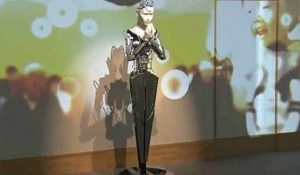In February 2024, Apple released a computer that you can wear on your face. If the iconic white wires of the company’s iPod earbuds or pearly tubular AirPods weren’t enough, you can now sheath your head in glossy Apple ski goggles with expensive googly eyes.
The Apple Vision Pro retails for US$3,499, a tidy chunk of change bound for the already silk-lined pockets of the world’s second-most-valuable company behind Microsoft. Promising the initiation of a new era of “spatial computing” with integrated augmented reality (AR) and virtual reality (VR) capability, the Vision Pro is anything but new. AR headsets have been commercially available from Microsoft since the first HoloLens in 2016, and the promise of superimposed reality was made as far back as the 1970s, with Star Trek’s “holodeck.”
In fact, retro sci-fi is now actively manifesting in the world around us, with a global penetration of more than 68 per cent for Trekkie communicators (smartphones),* and, notably, gargantuan tech corporations wielding more power—and acting more nefariously—than nation states. And as the stories we tell about technology continue to catalyze its development, it is worth re-examining certain seminal myths in an attempt to better understand the underlying inertia of our place in time.

Pygmalion’s Spectacles
Way back in 1935, a young American science fiction writer, Stanley G. Weinbaum, penned an enchanting 18-page story titled Pygmalion’s Spectacles, which was probably the first detailed treatment of a virtual-/augmented-reality device in modern literature. In masterful prose, Weinbaum summoned a vision of the future that by all accounts will continue become more uncanny as our present unfolds.
The tale begins with an abrupt and unsolicited conversation between a diminutive professor and bleary-eyed protagonist on a Manhattan street corner.
“But what is reality?” asked the gnomelike man. He gestured at the tall banks of buildings that loomed around Central Park, with their countless windows glowing like the cave fires of a city of Cro-Magnon people. “All is dream, all is illusion; I am your vision as you are mine.” (Weinbaum, 1)
An enticing hook, Prof. Ludwig unpacks his oddball icebreaker by sketching out the fundamentals of idealism, a philosophy set forth by the 18th century theologian and philosopher Bishop George Berkeley.
Inhabiting the ideal
Idealism posits that reality consists of nothing but minds and their ideas, with physical objects having no existence independent of perception. For Berkeley, it is the interaction of our five senses with the realm of ideas that generates the illusion of an independent external reality. In short, apples only exist to minds that can see and mouths that can taste, without these faculties there are no such things as an apples.
This view of an entirely mind-dependent reality sets up the gnome-like professor’s introduction of his “magic spectacles,” which are capable of summoning a universe-unto-itself for one lucky viewer. The protagonist, Dan Burke, takes the bait and is whisked into a Berkeleyan domain of fantastical sensations so enthralling that he becomes somewhat depressed with the “real” world upon removing the device.*
(At this point, I encourage the reader to take some time to absorb Pygmalion’s Spectacles firsthand; you won’t regret it!)

Visionary Pros
In donning our customary Digital Bodhisattva Dharma goggles, several important themes about technology’s role in the future of illusion jump to the foreground out of Weinbaum’s marvelous vignette.
First, it is valuable to double-click on the compelling map of Berkeley’s Christian-flavored idealism as a bridge to another visionary pro, Ajahn Buddhadasa Bhikkhu, whose Dharmic perspective on illusion may ultimately provide a way out.
A respected bishop in the Anglican Church of Ireland, Berkeley remained deeply committed throughout his life to both the Christian faith and idealist philosophical perspective by effectively wedding the two in holy matrimony.
Berkeley maintained that all ideas were originally caused by God and as such could be trusted, for the Divine would not deceive humanity. This point accounts for the ultimate order and stability perceived in the world of the Creator while still permitting our folly as ignorant monkeys capable of misinterpreting the sensations we receive from the infallible domain of ideas.
Complimentary Dharma
The Buddhist perspective takes a somewhat parallel approach but with the crucial substitution of “God” for “causality”—or pratītyasamutpāda (Skt. wheel of dependent origination; Pali: paṭiccasamuppāda). Categorically non-theistic, the Buddhist view holds that a fundamental mechanism of cause and effect underlies all experience from which every idea, sensation, and form springs. Seemingly spinning of its own accord, Ajahn Buddhadasa describes the Wheel of Life as such:
Dependent origination is in the middle between the ideas of having a ‘self’ and the total lack of ‘self.’ It has its own principle: ‘Because there is this, there is that; because this is not, that is not.’ It is this principle which makes Buddhism neither eternalism nor annihilationism. (Buddhadāsa Bhikkhu, 10)
Sandwiched between the theistic perspective of an ultimate ground in God (eternalism) and the nihilistic yawn of a cold unfeeling void (annihilationism), the Dharma points out a participatory function: a cycle that is engaged again and again as one thing leads to the next with awareness blindly tagging along for the ride.
Paṭiccasamuppāda is nothing more than a detailed analysis of suffering, its arising, its ceasing and the way leading to its ceasing. (Buddhadāsa Bhikkhu, ii)
Beyond a heady philosophical perspective, the teaching of dependent origination offers a practical map of cognition intended to guide practitioners into more lucid awareness of the flimsy nature of their own inner architecture. As one diligently cultivates the muscle of mindfulness in meditative practice, this architecture reveals gaps that can be gradually widened and inhabited, opening space for tranquility to emerge. Letting go of the hassle associated with constantly reinforcing a sense of self, the mind begins to cool and abide in the space between ideas.

Ignorance
Returning to the story, we read that, in spite of his best efforts, Dan Burke is roped steadily into the illusory world of the spectacles via his willful engagement with a torrent of delightful sensations. Without this “self-hypnosis” as Prof. Ludwig puts it, the show could not go on. Many flavors of Eden are presented to Dan in the otherworld of Paracosm, from a garlanded nubile maiden to the express confirmation that disease, old age, and death simply do not exist in her beatific realm. The innocence of ignorance animates the entire tale with biblical allusions perfectly fitting the Christian bent that Berkeley himself took on the nature of reality.
The Apple in the garden
Of course, Dan is aware that what he is experiencing is an illusion produced by clever technical trickery, yet he takes the bait nonetheless. Having fallen for the maiden and her dreamy domain, “real” life takes on a beige and increasingly unsatisfying tone. With a perceptive eye, one can discern too the same pattern occurring in the mechanics of infatuation with “real” people. The point being that virtual reality only amplifies inbuilt tendencies toward delusional thinking, which is perhaps why it is so attractive. We find then that to possess Apple’s shiny new spectacles is to possess the power to reshape one’s reality, to blur out the rough edges, and to contour the world to one’s pleasing.
If, with one tantalizing trinket, we can slip into a self-styled Eden, perhaps we could finally be free of that nagging sense of dissatisfaction which haunts waking life. Yet the very tool that transports us will only facilitate deeper delusion, constantly reminding us that the paradise we crave is, in fact, lost.

Spatial samsara
Buddhists call this troubling feedback loop samsara, and note the pernicious tendency of mind to continually fabricate all manner of “solutions” to its intractable problem. Ignorance plays a central role in the machinery of samsara being at once the driver of delusion and the point of contact where clarity can emerge.
As Buddhadasa Bhikkhu explains:
When ignorance clouds the mind, suffering arises; when mindfulness and wisdom govern the six sense doors (eyes, ears, nose, tongue, body and mind), suffering ceases. This is a paṭiccasamuppāda that we can practice, because both the causes and effects exist here and now, where we can get at them. (Buddhadāsa Bhikkhu, iii)
Suffering often masquerades as pleasure for it is our attachment (Pali. upādāna) to the “good” that sets up an eternal evasion of the “bad.” Pinging between these poles the “self” solidifies with all its accoutrements of preference and pride that characterize the miracle of “me.” We already project these sketches of self into the world as ideology and idiosyncrasy, but it now appears that the day has dawned when the world can project them back onto us.
With spatial computing we extend curated digital artifacts into our physical environment, pinning virtual workstations to blank walls and slideshows to dreary vistas. While samsara was always been spatial, luxury consumer electronics such as the Vision Pro have unlocked what appears to be a new era of editable reality.
Airborne anecdote
This point is perhaps best illustrated in an anecdote of the first time I saw someone using the Apple Vision Pro. Filing past business class on a connecting flight from Kuala Lumpur, there sat a gentleman in the second row of plush double-wide seats. Occupying an aisle position, the man’s eyes loomed ghostly purple through the weird computer strapped to his face. His fingers were intently groping thin air, pinching who knows what inches from my waist as I shuffled past on the way to my economy seat. This situation was both physically and socio-economically uncomfortable.
Not only were we airborne monkeys already exercising a distinct privilege to dramatically shift physical location via jetliner, but the wealthiest aboard had decided to erase the rest of us from his view. Cloistered in a virtual bubble he sat unperturbed as every passenger was subjected to the sight of this proud man displaying his prestige.

Together we dream
I share this experience not to poopoo the rich but to point to perhaps the most foreboding aspect of this new technology.
COVID-19 brought into high relief just how entangled tech has become with global class division as those who could work online stayed safe while everyone else had to seriously eke by with whatever they could manage. The digital divide is a major feature of modern inequality and we now have devices that can operate as literal blinders to the less fortunate.
Whether we retreat into a pixelated promised land or persevere in the present, it is important to remember that we are all in this together. One can try to evade discomfort by layering oneself in expensive virtual pleasantries, but our continuation will still depend on a whole cosmos of favorable conditions and anonymous others ensuring that food, water, and warmth are close at hand.
With interdependence continuing to bind worlds together, the least we can do in weaving our shared fictions is to respect each other and perhaps remember Prof. Ludwig’s whimsical words:
All is dream, all is illusion; I am your vision as you are mine. (Weinbaum, 1).
* Global smartphone penetration rate as share of population from 2016 to 2022 (Statista)
References
Weinbaum, Stanley G. 1935. Pygmalion’s Spectacles. Classicly: https://www.classicly.com/bibi/pre.html?book=1407.epub
Buddhadāsa Bhikkhu. 1986. Paṭiccasamuppāda: Practical Dependent Origination. Suan Mokh: https://www.suanmokkh.org/system/books/files/000/000/126/original/Buddhadasa-Paticcasamuppada-20200319.pdf?1599466277
See more
People Are Doing Some Interesting Things With the Apple Vision Pro (Intelligencer)
Digital Bodhisattva (Facebook)
Digital Bodhisattva (Clubhouse)
Digital Bodhisattva Initiative (Linktree)
International Network of Engaged Buddhists (INEB)
INEB (Twitter)
Related features from BDG
Praise for a Hopepunk Psalm
Vienna in the Silicon Pure Land, Part 1: Feeling into the Dharma of Emerging Technology
Vienna in the Silicon Pure Land, Part 2: Navigating the Wild Wired West
Vienna in the Silicon Pure Land, Part 3: Reimagining Buddhist Economics
Vienna in the Silicon Pure Land, Part 4: Making Dharmic Finance Cool
Related videos from BDG
BDG Special Issue
Digital Dharma – Buddhism in a Changing World














